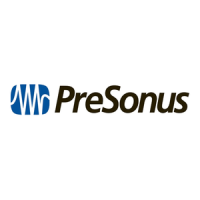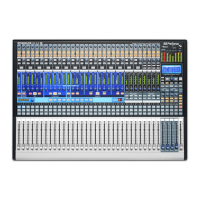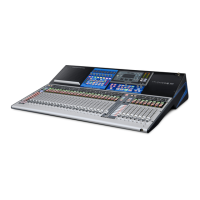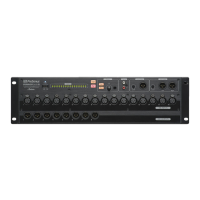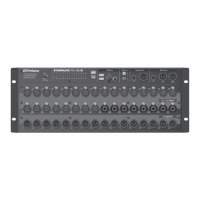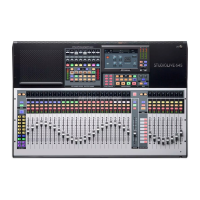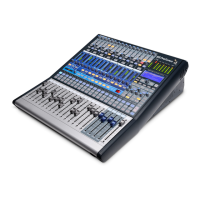Do you have a question about the PRESONUS StudioLive 32SX and is the answer not in the manual?
Step-by-step guide to setting initial input and output levels.
Covers onboard SD recorder and USB audio interface for recording and playback.
Details routing any input to any channel and any mix to any output.
Details rear panel I/O configurations for StudioLive 64S and 32S models.
Explains various rear panel connectors and their functions.
Details Mic/Line, Mic Only, and +48V phantom power inputs.
Details Sub Outputs, Mix Outputs, and Main L/R/Mono outputs.
Explains AES, Audio Network, Ethernet, and USB ports.
Explains the layout and controls of a typical StudioLive channel strip.
Explains Filter DCA groups for controlling channel volume and managing complex mixes.
Explains FlexMixes as versatile buses configurable for Aux, Subgroup, or Matrix functions.
Details creating auxiliary mixes for monitors or external effects.
Explains selecting send positions for Aux mixes (Pre 1, Pre 2, Post).
Step-by-step guide to creating custom monitor mixes.
Explains subgroups for grouping channels and applying shared processing.
Steps to create a subgroup using FlexMixes.
Explains matrix mixes for flexible routing to multiple locations or zones.
Details FX buses for sending signals to internal effect processors.
Explains the dedicated Mono/Center bus on the StudioLive 64S.
Explains LCR Pan mode and Center Divergence for precise channel placement.
Introduces the Fat Channel as the core signal processing and mixing tool.
Explains using the A/B button for comparing EQ and compressor settings.
Details copying Fat Channel settings and loading/saving presets.
Explains Dynamic and Fixed Fat Channel modes.
Details the fixed encoder functions on specific StudioLive models.
Explains accessing input controls and displays via the Input button.
Details Noise Gate and Expander parameters and controls.
Introduces compressor parameters and plug-in models.
Details controls for the Standard Compressor model.
Details controls for the Tube Leveling Amplifier compressor model.
Details controls for the Class-A FET Compressor model.
Introduces EQ parameters and plug-in models.
Details controls for the Standard EQ model.
Details controls for the Passive Program EQ model.
Details controls for the Vintage 1970s EQ model.
Overview of different Fat Channel screen displays.
Details the Channel Overview screen parameters.
Lists available compressor plug-in models and their functions.
Lists available EQ plug-in models and their functions.
Details controls for managing input sources and levels.
Explains selecting input sources like Analog, Network, USB, SD Card.
Steps to create a new session for recording to an SD card.
Details the Capture screen for multitrack recording and playback.
Guides on using Capture's Virtual Soundcheck mode for mixing.
Introduces internal effects processors and the FX Rack screen.
Managing mixer settings via Projects and Scenes.
Explains Solo bus, monitor outputs, and headphone jack for monitoring.
Using SIP mode for mix setup and channel dialing.
Explains using the RTA for monitor setup and feedback elimination.
Accesses audio routing options and digital patching screen.
Lists technical specifications for microphone preamplifiers and line inputs.
Shows default input source routing for various models.
Common troubleshooting steps and resources.
Step-by-step guide to setting initial input and output levels.
Covers onboard SD recorder and USB audio interface for recording and playback.
Details routing any input to any channel and any mix to any output.
Details rear panel I/O configurations for StudioLive 64S and 32S models.
Explains various rear panel connectors and their functions.
Details Mic/Line, Mic Only, and +48V phantom power inputs.
Details Sub Outputs, Mix Outputs, and Main L/R/Mono outputs.
Explains AES, Audio Network, Ethernet, and USB ports.
Explains the layout and controls of a typical StudioLive channel strip.
Explains Filter DCA groups for controlling channel volume and managing complex mixes.
Explains FlexMixes as versatile buses configurable for Aux, Subgroup, or Matrix functions.
Details creating auxiliary mixes for monitors or external effects.
Explains selecting send positions for Aux mixes (Pre 1, Pre 2, Post).
Step-by-step guide to creating custom monitor mixes.
Explains subgroups for grouping channels and applying shared processing.
Steps to create a subgroup using FlexMixes.
Explains matrix mixes for flexible routing to multiple locations or zones.
Details FX buses for sending signals to internal effect processors.
Explains the dedicated Mono/Center bus on the StudioLive 64S.
Explains LCR Pan mode and Center Divergence for precise channel placement.
Introduces the Fat Channel as the core signal processing and mixing tool.
Explains using the A/B button for comparing EQ and compressor settings.
Details copying Fat Channel settings and loading/saving presets.
Explains Dynamic and Fixed Fat Channel modes.
Details the fixed encoder functions on specific StudioLive models.
Explains accessing input controls and displays via the Input button.
Details Noise Gate and Expander parameters and controls.
Introduces compressor parameters and plug-in models.
Details controls for the Standard Compressor model.
Details controls for the Tube Leveling Amplifier compressor model.
Details controls for the Class-A FET Compressor model.
Introduces EQ parameters and plug-in models.
Details controls for the Standard EQ model.
Details controls for the Passive Program EQ model.
Details controls for the Vintage 1970s EQ model.
Overview of different Fat Channel screen displays.
Details the Channel Overview screen parameters.
Lists available compressor plug-in models and their functions.
Lists available EQ plug-in models and their functions.
Details controls for managing input sources and levels.
Explains selecting input sources like Analog, Network, USB, SD Card.
Steps to create a new session for recording to an SD card.
Details the Capture screen for multitrack recording and playback.
Guides on using Capture's Virtual Soundcheck mode for mixing.
Introduces internal effects processors and the FX Rack screen.
Managing mixer settings via Projects and Scenes.
Explains Solo bus, monitor outputs, and headphone jack for monitoring.
Using SIP mode for mix setup and channel dialing.
Explains using the RTA for monitor setup and feedback elimination.
Accesses audio routing options and digital patching screen.
Lists technical specifications for microphone preamplifiers and line inputs.
Shows default input source routing for various models.
Common troubleshooting steps and resources.
| Channels | 32 |
|---|---|
| Inputs - Mic Preamps | 32 |
| Phantom Power | Yes |
| Inputs - Line | 32 |
| Effects | Yes |
| USB | Yes |
| MIDI I/O | Yes |
| Digital Effects | Yes |
| Recording Interface | Yes |
| Sample Rate | 96 kHz |
| Preamp Type | XMAX |
| Built-in Talkback Mic | Yes |
| Outputs - Aux | 16 |
| Busses/Groups | 16 |
| EQ Bands | 4-band |
| Data I/O | Ethernet |
| Computer Connectivity | USB |
| I/O Resolution | 24-bit |
| Software | Studio One Artist |
